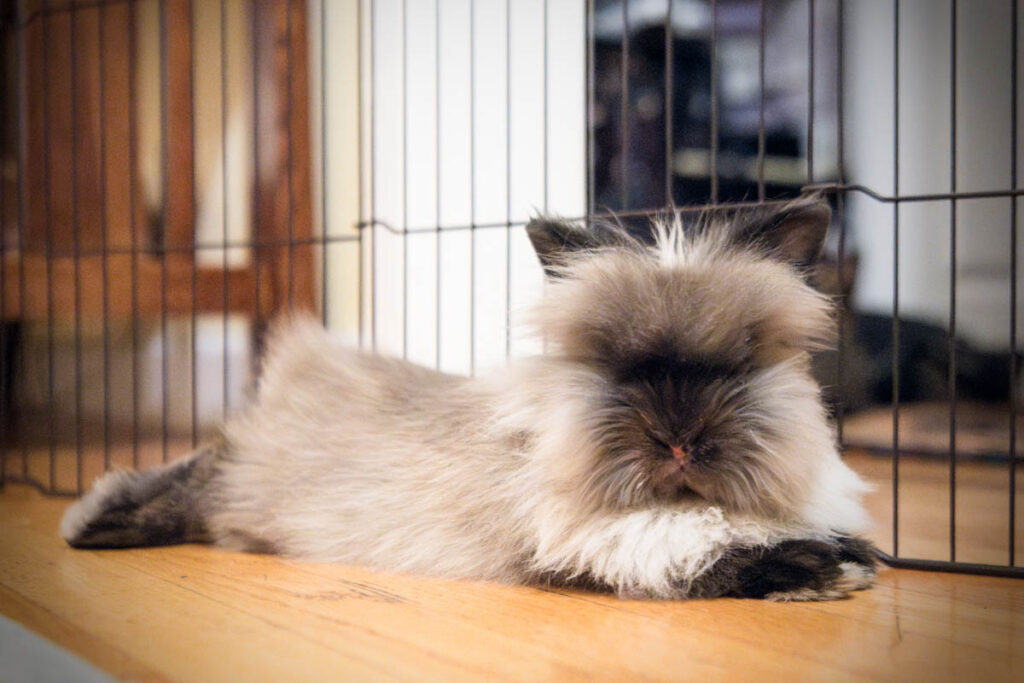I don’t understand it. Just this week, Fluffy has bitten the kids five times.” “I don’t understand it. Peanut used to be so good about using his litterbox. Now he’s leaving messes everywhere.” “I don’t understand it. Flora was such an easy-going little bunny. Now all she does is dig, dig, dig. My carpet is in shreds.”
“Why does Felix keep running in circles around our legs all the time?”
“The other day I found Josie pulling out her own fur and running around the house with it in her mouth!”
Adolescence-or at least the outward manifestations of it-can strike bunnies almost overnight. Your fluffy little darling’s hormones switch on, and she enters a phase that can transform her and mystify the unprepared human. Here are a few of the ways to recognize, understand, and deal with your teenager.
WHEN
Adolescence can begin as early as three months, especially in the dwarf breeds. Five to six months is the more common starting point. Generally rabbits make the transition from adolescence to adulthood at about one year.
WHO IS THIS LONG-EARED TERROR?
It’s no surprise that the majority of rabbits surrendered to shelters are between six and twelve months of age. In some cases, of course, the reason is that the novelty and cuteness factors have worn off. But more often Thumper’s sudden change from easily controlled to impudent and assertive convinces people that they have a “mean” or “bad” rabbit. Very few of these lunging, chewing, digging, nipping guys get adopted, and what is a normal, natural, and necessary phase of life becomes a fatal disease when Thumper gets euthanized.
The key word here is phase. If you and Thumper manage to survive adolescence together, you will find at the other end of the experience a larger, calmer version of your pre-adolescent pal. If you’re adopting a six- to twelve-month-old rabbit, you can assume his adult personality will be a less exaggerated version of his teenage self. When I rescued Daphne, she was a confident, affectionate eight-week-old baby. When she was about six months old, it occurred to me that she was no longer following me from room to room; she was chasing me, chin thrust forward, tail up, occasionally nipping my ankle if I didn’t move fast enough for her satisfaction.
YOUNG LUST
As with humans, sexuality plays a major role in the behavioral changes that accompany adolescence. These may include spraying urine, circling, mounting, nipping, nest-building, extreme mood-swings, digging, and fighting between previously friendly rabbits (especially males). The simple cure for all of these activities, discussed in an earlier issues (Vol. I, #1 & Vol. I, #2), is to spay/neuter your rabbit. General age guidelines are four months for males and six months for females. According to Dr. Carolynn Harvey, males can be neutered as soon as the testicles descend. “If I can see them, I can remove them,” she assured me, when I called her about the two ten-week-old brothers I’d rescued who were remorselessly mounting their two sisters and terrorizing all of our cats.
Because there is a social as well as a sexual component to many of these behaviors, and because it takes time after surgery for the hormones to stop circulating (usually two weeks for males, as much as six months for females), surgery is not an instant cure. But it is a necessary part of surviving adolescence. There are no physiological or behavioral disadvantages to spaying and neutering. And no discussion would be complete without mentioning the enormous ethical advantages. With rabbits being euthanized daily at shelters across the country, and thousands more being “set free” in fields or vacant lots, it’s difficult to reconcile a love of rabbits with bringing more of them into the world. Killing-even a gentle death at the hands of a caring shelter worker-and abandonment are not acceptable methods of population control.
SURVIVAL TECHNIQUES
So you’ve had Flopsy spayed. She’s still digging your carpet, eating your rattan love seat, biting the kids when they reach into her cage, and leaving liquid and solid calling cards all over the house. The first step is to get out your old HRJs and read the relevant articles on chewing, digging, housetraining, etc. As you read, a few underlying concepts will emerge from the specific suggestions.
- Redirect. It’s much easier to tell a rabbit “Chew this” (“…and this,” “…and this,”) than to try to convince him not to chew anything. Look for ways that Thumper can indulge his natural inclinations -whether for chewing, digging, mounting, etc.-in ways that don’t drive you crazy. Meet him halfway. Remember that from his point of view, he’s being a very good bunny. Adolescent rabbits are supposed to chew, dig, mark their territory, and mount everything in sight. It’s only our human perspective that puts a negative spin on the situation.
- Set her up to succeed. Pun-ishment doesn’t work very well with rabbits, especially sassy teenage rabbits. Instead, put Flopsy in a situation where her options are limited to doing the right thing-that is, the human version of the right thing, such as digging in her sandbox instead of your carpet. Setting up for success often includes limiting and structuring her physical environment.
- Be patient. She will outgrow all this mania. Enjoy her exuberance, laugh at her mischievousness, ponder the complexity of the rabbit psyche. Allow yourself to be infected by her joy at being alive and obnoxious and pushy. Once you’ve seen a rabbit kick up her heels, shake her head, leap straight up in the air and make a 180-degree turn before landing, you’ll know you’ve been initiated into a very select society. And you’ll remember why you put up with all the other stuff.
©Copyright Amy Espie. All Rights Reserved. Republished with the permission of the author.

